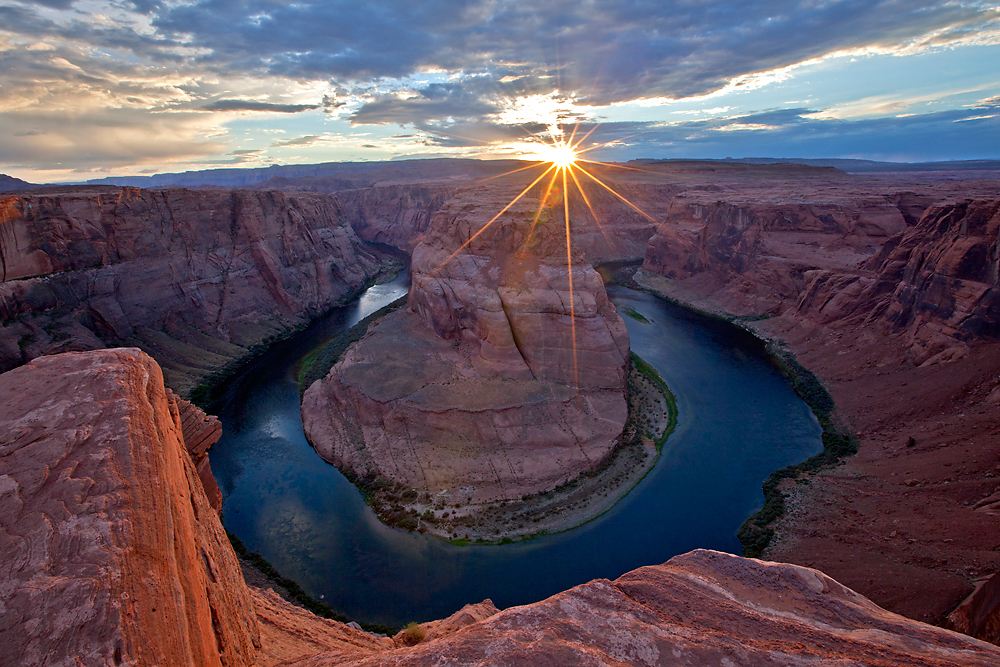
From the artist
For millennia, the rushing waters of the Colorado River have carved a sinuous path from Glen Canyon to Marble Canyon. Now, the river meanders through the Horseshoe Bend, where the desert floor dramatically drops 1,000 feet to provide visitors a breathtaking view of one of the last stretches of scenic Glen Canyon that remained untouched after the completion of Glen Canyon Dam in 1966. Today, from all ends of the Earth, amateur and professional photographers alike flock to record the view one of Arizona’s most iconic, awe-inspiring overlooks.
Each season and every day sheds new light on this classic scene. Winter months see clear, crisp blue skies…and few visitors. Desert monsoon storms during the summer months usher in moody storm clouds, but the warmer temperatures also attract much larger crowds of people from across the world. Each September, clusters of golden rabbit brush blooming along the trail and individual broom snakeweed sitting precariously on the cliffs’ edge add splashes of color to make this unforgettable sight even more unique.
To capture your own stunning photographs of this geological gem, plan to make the three-quarter mile (1.2km) hike such that you arrive at the canyon’s rim about 30 minutes prior to sunrise. A headlamp or a flashlight will help illuminate your way in the dark along this well-defined, but sometimes sandy and rocky trail. As you creep closer to the edge, watch your step – especially when it’s windy or icy! There are no guardrails, and even photographers who are not acrophobic sometimes feel a temporary sense of vertigo.
Before the sun breaks the eastern horizon, begin photographing this evenly-lit, warmly-saturated landscape with a wide-angle lens, preferably a 20mm or wider to ensure the entire bend fits into a single horizontal frame without cutting off the river below. Be sure to pack a tripod and a cable release or a wireless remote trigger to keep your camera steady during slower shutter speeds dictated by the morning’s low light.
As soon as the first light of day touches the distant Vermilion Cliffs, the scene turns into a high-contrast lighting situation throughout the rest of the day until sunset, creating difficulties in maintaining proper exposure in your frame unless clouds diffuse the sun. Placing a 2- or 3-stop graduated neutral density filter in front of your lens will help balance this extreme exposure contrast between the sky and the rock. Also, using a polarizing filter will intensify the water’s color saturation and darken its tonality.
While pre-dawn light is ideal, visiting this location at the end of the day enables shutterbugs to capture a radiating sun star over the bend. To accomplish this effect, stop down to a small aperture such as f/16 or f/22 and remove all filters from the front of your lens. Photograph into the sun as it hides behind a cloud or starts to sink below the western horizon to record an eye-catching sunburst.
No matter the timing of your visit, maximize your depth of field by using a smaller aperture such as f/16 or f/22, especially if you include the orange-colored rocks in the foreground of your frame. Once you have captured a horizontal version of this classic image, be sure to isolate one side of the bend using a vertical composition.
Once you’ve recorded the beauty of Horseshoe Bend with your pixels or film, don’t forget to put the camera down for a few minutes to admire this remarkable work art by Mother Nature with your own eyes!
About the Photographer
 As an award-winning, internationally published outdoor photographer and writer, Colleen Miniuk-Sperry supports a wide range of assignments for editorial clients, fine art, and stock. Her work has been published in National Geographic calendars, the Arizona Highways magazine, books, and calendars, AAA Highroads, Mushing Magazine, Lighthouse Digest, Smith-Southwestern calendars, and a broad variety of other publications. In late 2011, she co-authored and published the book, Wild in Arizona: Photographing Arizona’s Wildflowers, A Guide to When, Where, and How
As an award-winning, internationally published outdoor photographer and writer, Colleen Miniuk-Sperry supports a wide range of assignments for editorial clients, fine art, and stock. Her work has been published in National Geographic calendars, the Arizona Highways magazine, books, and calendars, AAA Highroads, Mushing Magazine, Lighthouse Digest, Smith-Southwestern calendars, and a broad variety of other publications. In late 2011, she co-authored and published the book, Wild in Arizona: Photographing Arizona’s Wildflowers, A Guide to When, Where, and How, which includes Horseshoe Bend and 59 other locations to find Arizona’s blooms throughout the year.
Colleen also leads photography workshops for the Arizona Highways Photography Workshops, Arizona Wildlife Federation, Through Each Others Eyes, and numerous private workshops. Colleen is an active Associate of Through Each Others Eyes (TEOE) and a member of Outdoor Writers Association of America (OWAA).
Originally hailing from Ohio, Arkansas, and Illinois, Colleen currently resides in Chandler, Arizona with her Outdoor Writers Association of America (OWAA). husband, Craig and cat, Nolan. To see more of her work, visit her website at www.cms-photo.com and her blog at www.youcansleepwhenyouredead.com.

